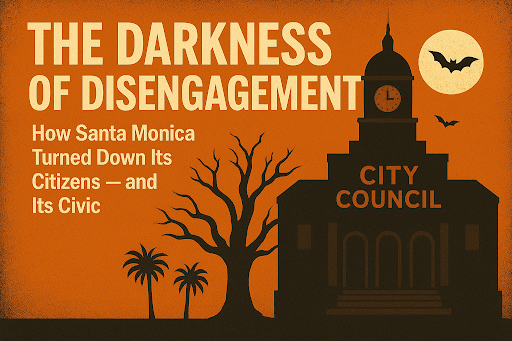
In a move that stunned many civic leaders, the Santa Monica City Council voted this fall to suspend and overhaul the Neighborhood Organization Grant Program, cutting off funds that for years had helped the city’s seven recognized neighborhood groups communicate with residents.
Each organization, from Friends of Sunset Park to the Ocean Park Association, once received up to $7,000 annually to maintain websites, distribute newsletters, host meetings, and represent residents in planning and policy discussions. Now, under new “oversight and compliance” rules, that system has been replaced with stricter restrictions, city-approved messaging standards, and the threat of suspension for groups that venture into “political territory.”
The decision wasn’t about money. It’s hardly a rounding error in Santa Monica’s yearly budget. However, as one former city staffer pointed out, “Defunding the neighborhood groups isn’t about money, it’s about control. When you cut their resources, you decrease their influence.”
If that sounds familiar, it should. It’s a similar strategy that defined Donald Trump’s relationship with the media: discredit, defund, and drown out independent voices until only one narrative remains: the official one, Message control 1.0.
In Washington, it looked like attacking the press as “fake news.” In Santa Monica, it appears to involve cutting off any perceived “political microphones” and diminishing the financial organizational capabilities of the city’s neighborhood associations: a different scale, but kind of the same playbook.
“Neighborhood groups are the front line of local democracy,” said one Ocean Park board member. “We’re volunteers who give our time to keep residents informed. Without even minimal support, we can’t do our job, and that’s exactly what some people in City Hall prefer.”
City officials insist otherwise. Their sales pitch is “Neighborhood engagement remains a priority,” one councilmember said during deliberations. “We’re simply reevaluating how to best support communication citywide.” But residents aren’t buying it. “They say they want engagement,” said a neighborhood leader, “but they just made it harder for us to engage.”
It’s understandable why the Council might want to make it more difficult for neighborhoods to communicate. These groups often challenge development deals, budget priorities, wasteful spending, and policy changes driven by staff or outside interests. They’re loud, passionate, and democratic; all the things this City Council dislikes.
By removing and further controlling their modest funding, the city effectively weakens one of the few organized checks and balances on its power. As one retired planning commissioner put it, “It’s easier for City Hall to say it’s ‘listening to residents’ when there’s no one left to talk back.”
The irony is rich. Santa Monica’s elected officials regularly proclaim their commitment to transparency, inclusion, and participation. Yet, while they fund PR consultants and social media “engagement campaigns,” they’ve defunded and virtually ignored the most authentic, organic form of civic engagement the city has ever had.
Even more misguided is the City’s decision to reinstate Seascape, the glossy citywide magazine, as an annual publication at an estimated cost of $200,000. In a year when neighborhood groups were stripped of a few thousand dollars each, funds that directly supported local democracy, City Hall somehow found the budget for a high-priced public relations brochure. It’s a telling contrast: polished messaging wins out over genuine resident communication.
The outcome? A city that appears more refined externally but feels less democratic internally. “You can’t call it participatory democracy when you’ve cut the mic,” commented one resident after the vote.
A city once characterized by civic pride now suffers from a tarnished image, and the repercussions are worse. Neighborhood groups have been among the few consistent watchdogs of city bureaucracy, particularly as residents grow more frustrated with rising development, reduced public input, and opaque decision-making processes. This frustration was evident in the recent protests over the proposed mental health care facility on Ocean Avenue, which residents had no prior knowledge of or input on, until Los Angeles County Supervisor Lindsey Horvath finally stepped in and cancelled the project.
“When a project moves forward without community awareness, it erodes trust. In this case, that trust has been broken, and the community is right to be frustrated,” Horvath said.
Santa Monica used to be a model for community-driven governance, where neighborhood voices mattered. Just as Trump learned that controlling the press influences public perception, Santa Monica’s leaders seem to have realized that regulating neighborhood groups and limiting their input makes managing dissent much easier.
And in the latest — and perhaps most tone-deaf — decision made by the City Council, they have once again demonstrated that Democracy and civic engagement, it seems, are being ignored and devalued at the ground level. Hundreds of residents either spoke up, wrote, and pleaded personally for the City Council to extend a short deadline for RPG’s Santa Monica Civic Auditorium restoration, a privately funded $300–$400 million project that would have preserved one of the city’s most important landmarks and created a unique economic stimulus that most cut-and-paste corporate concepts can’t duplicate. Instead, they all were brushed off and ignored, including RPG’s representative, like unwanted traffic noise. RPG was thus disincentivized to continue and shown the door.
Apparently, with our city’s “essentially broke” cash flow status and potential bankruptcy, it makes total sense to reject a 100% paid-for major private investment by a well-known and successful entertainment company. Yet, they still feel it is necessary to somehow regulate the very neighborhood groups that give residents a strong voice.
The Santa Monica City Council has sacrificed something even more essential: the natural, unfiltered connection and engagement between government and the people. And in a city that once celebrated its neighborhoods as the core of democracy, and a vision of transparency and inclusion, that’s a loss in value that can’t be measured in dollars.
Michael Jolly for SMa.r.t.
Santa Monica Architects for a Responsible Tomorrow
Samuel Tolkin, Architect & Planning Commissioner; Thane Roberts, Architect; Mario Fonda-Bonardi AIA, Architect; Robert H. Taylor AIA, Architect; Dan Jansenson, Architect & Building and Fire-Life Safety Commission; Michael Jolly, AIRCRE; Jack Hillbrand AIA, Landmarks Commission Architect; Matt Hoefler NCARB, Architect.
Mario Fonda-Bonardi, AIA, former Planning Commissioner, Robert H. Taylor, AIA, Architect, Dan Jansenson, former Building and Life Safety Commissioner, Samuel Tolkin, Architect, former Planning Commissioner, Matt Hoefler, NCARB, Architect. Michael Jolly, AIR-CRE, Jack Hillbrand, AIA, Landmarks Commission Architect, Phil Brock, Santa Monica Mayor (ret), Thane Roberts, Architect;













